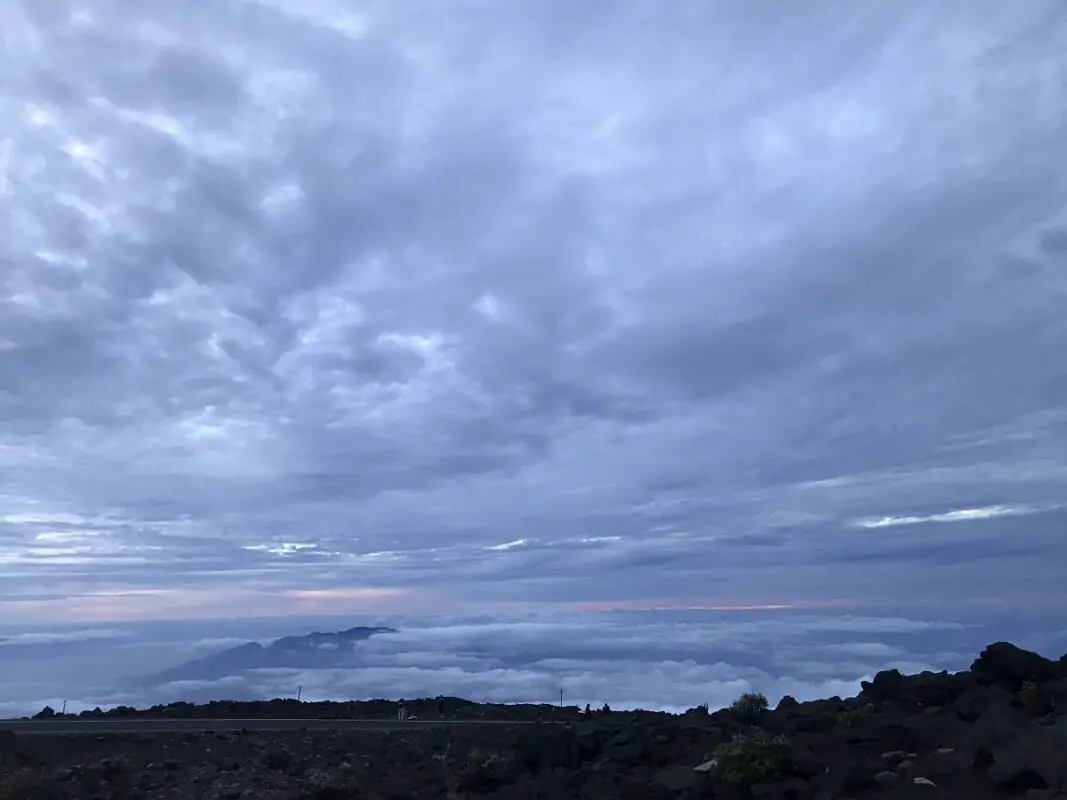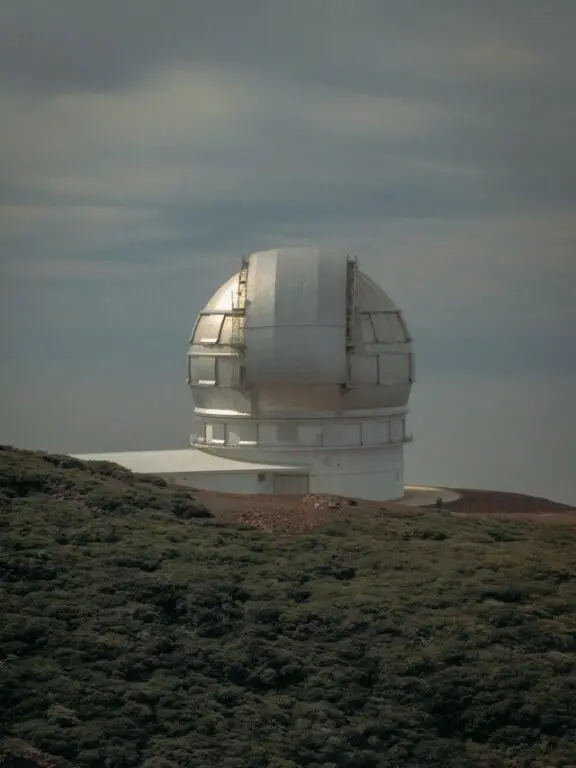For over a century, engineers have been building observatories for professional telescopes at increasingly higher elevations, from the famous Mount Wilson Observatory in California (1700m) to the TAO in Chile (5640m). But why are telescopes put on mountains? There are numerous reasons for this, but it is mainly because mountaintop observatories avoid light pollution, atmospheric turbulence, and cloud cover.
In 2018, while on my honeymoon, I was able to drive to the summit of Haleakalā, Maui. which sits at 10,000 ft (3000m) above sea level. Once it gets dark, it becomes immediately obvious why telescopes are put on mountains. The absence of light pollution, plus being above some of the turbulent atmosphere, makes for some of the most incredible views of the night sky you will ever experience.
As you can see from the image below, while there is still high cloud around, we’re standing above the low cloud cover.

In this article we’ll learn more about why professional telescopes are built on mountaintops and how you can apply this knowledge to your observing sessions.

Light Pollution
Mountainous regions tend to be sparsely populated. In the absence of high-density housing, super-plazas, stadiums, highways, and other brightly-lit structures, astronomers have much less light pollution to contend with.
Light pollution is the single biggest impediment to visual astronomy around the world, drowning out thousands of stars and rendering faint galaxies and nebulae invisible.
Backyard Solution
Take advantage of dark sky locations whenever you can. Refer to light pollution maps to gauge the suitability of an observing location. Better yet, find out if there is a designated dark site near you. Plan your trip close to the new moon to take full advantage of the darkness.
For the times when you can’t escape city lights, a couple of well-chosen filters can help to some degree. Narrowband filters such as the Optolong L-eXtreme or similar work extremely well for emission nebulae, though I’ve had less luck with so-called “ultra-high contrast” broadband filters. Also make sure the filter you select is designed for your intended use (visual or photography).
Clouds
The most obvious reason for putting a telescope on a mountaintop is to escape cloud cover. Mountaintop observatories sit clear of low clouds and allow astronomers to squeeze more valuable observing time into each year.
No matter where you live, stargazing a weather-dependent activity and you will have to account for this when planning an outing.
Backyard Solution
Check forecasts frequently from multiple weather apps. A possibility of precipitation greater than 20% is a no-go for me. Keep in mind that forecasts can change dramatically over the course of a few days, and anything more than 24 hours before your target date should be used as a guideline only.
Transparency
Billowy clouds are not the only thing which can obstruct your view of the stars. Invisible water vapour, industrial emissions, and wildfire smoke can all reduce the transparency of the air, which is another reason telescopes are built at high altitudes. Not to be confused with astronomical seeing (see below).
Backyard Solution
While you can’t prevent poor transparency, you can still enjoy observing on such nights. Bright objects such as the moon, planets, binary stars, and even globular clusters are largely unaffected by poor transparency, so simply modify your observing plan to fit the conditions.
Some astronomy apps and websites such as cleardarksky.com include seeing and transparency forecasts which can assist you in planning your sessions.
Seeing
Earth’s atmosphere is complex and often turbulent, with variations in temperature and wind speeds mixing things up at different altitudes. These conditions are referred to as “seeing” and can vary drastically night to night and even hour by hour. Poor seeing results in blurry images, much like viewing through water. It is also what makes stars twinkle.
Mountaintop observatories are high enough to avoid much of this turbulence, but the most advanced Earth-based telescopes also use adaptive optics to compensate for atmospheric turbulence. Seeing is also a big reason space telescopes are a thing.
Backyard Solution
Though you can’t control high-altitude seeing, you can control “local seeing”. This refers to heat shedding from rooftops or other warm surfaces. Point your telescope away from such obstacles if possible.
Avoid observing over rooftops, and don’t even think about using your telescope indoors by pointing through an open window! Also remember to let your telescope cool to ambient temperature to avoid tube currents.
The good news is that seeing primarily affects lunar, planetary, and binary star viewing while having minimal impact on faint fuzzies like galaxies and nebulae, so once again you can modify your plan to suit the conditions.
And even if seeing seems poor, don’t give up on those planets; pockets of steady air can materialize unexpectedly. I’ve had some of my best views on nights which seemed hopeless.
360-Degree View
Another obvious advantage of a mountaintop observatory is the complete absence of obstructions in any direction, allowing astronomers full access to the sky in every direction at all times of the year.
This is important since the sky rotates about the celestial poles and telescopes must track objects during long photographic exposures. And while one doesn’t need thousands of metres of elevation to obtain such views, it certainly doesn’t hurt.
Backyard Solution
An ideal observing location should have a large amount of sky available while also being shielded from direct lighting. If your view if partially treed-in, you can still take advantage of what sky is available. Use an astronomy app like Sky Safari to scout the view and find out which targets will be clear of the trees at different times in the night. Look beyond the usual showpiece objects and check out some binary stars or lesser-known faint fuzzies.
Non-visible Wavelengths
Optical astronomy is only one part of what professional observatories do. Visible light is, after all, but a tiny fraction of the electromagnetic spectrum. By observing at non-visible wavelengths, such as infrared and submillimetre, astronomers can view parts of the sky normally hidden from sight, penetrating interstellar dust clouds to discover stellar nurseries and resolving intricate detail in distant galaxies.
Because Earth’s atmosphere readily absorbs infrared wavelengths, such telescopes are typically situated at very high elevations. But there isn’t any sort of market for amateur infrared astronomy, so this is not something you will likely need to ever worry about.

